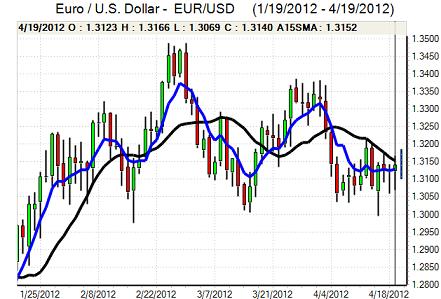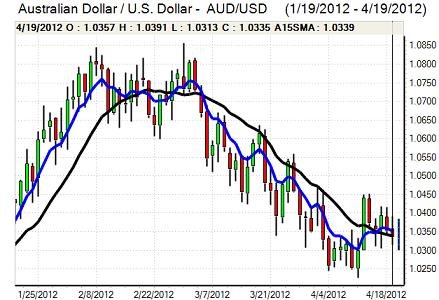EUR/USD
The Euro found support in the 1.31 region against the dollar in early Europe on Thursday and strengthened into the Spanish bond auction with markets optimistic over firm investor demand.
There was a bid/cover ratio above 2.0 which provided some relief, although it was a relatively small auction and there was an increase in yields to 5.74% from below 5.50% previously which reinforced fragile underlying sentiment. After an initial spike higher, the Euro was subjected to sharp selling pressure ahead of the US open.
There was an underlying lack of confidence in the Euro-zone outlook with particular fears surrounding the Spanish banking sector and rumours of a French credit-rating downgrade. There was a report from ratings agency Moody’s that Spanish and Italian borrowing costs were already at unsustainable levels from a medium-term perspective.
There were important medium-term concerns surrounding deleveraging pressures within the banking sector which could severely destabilise the Euro-zone economy and the Euro retreated to lows near 1.3070.
The latest US jobless claims was again weaker than expected with a figure of 386,000 in the latest week from a revised 388,000 previously which was the highest level since January. The other US data was also weaker than expected as existing home sales dropped to an annual rate of 4.48mn from 4.60mn previously. There was also a decline in the Philadelphia Fed index to 8.5 for April from 12.5 which was also the weakest since January as new orders were weak.
The data had a negative impact on risk appetite which provided some support for the dollar on defensive grounds. There was also renewed speculation that the Fed could consider further quantitative easing which would have an important negative impact on the currency. The US currency held firm against the commodity currencies, but was unable to extend its advance against the Euro and the Euro rallied back to the 1.3150 area.

Source: VantagePoint Intermarket Analysis Software
Call now and you will be provided with FREE recent forecasts
that are up to 86% accurate* 800-732-5407
If you would rather have the recent forecasts sent to you, please go here
Yen
The dollar maintained a generally firm tone against the yen in Europe on Thursday and pushed to highs around 81.70 before being pushed weaker by weaker than expected US economic data. There was a dip in US yield support which undermined immediate support for the US currency. There was also renewed speculation that the Fed could consider additional quantitative easing
The yen was unable to gain full support, especially with expectations that the Bank of Japan would also maintain an aggressive monetary policy and would also consider additional policy measures at next week’s policy meeting.
These expectations were important in curbing yen support as the dollar held firm near 81.50 with a mood of caution ahead of the two policy meetings.
Sterling
Sterling pushed to five-month highs against the dollar on Thursday with a peak just above 1.6070 before a rapid retreat to near 1.60 as the US currency gained wider support. There was support at lower levels with a move back to 1.6050 as the Euro retreated to 20-month lows against Sterling.
Monetary policy remained a key focus following Wednesday’s Bank of England minutes. MPC member Posen confirmed that he had taken a different stance than that in 2011 with reduced fears surrounding a sharp deterioration in economic conditions. Posen also stated that the economy was stronger than would be registered in the official growth data.
The banking sector will remain an important focus and there will be unease if there is a wider deterioration in European financial-sector conditions, but Sterling for now has been able to maintain its defensive role.
Swiss franc
The dollar was again blocked in the 0.92 area against the franc on Thursday and retreated back to the 0.9150 area. The Euro was again unable to gain any traction against the Swiss currency during the day. The National Bank is likely to be very uneasy surrounding the situation as the Euro has been resolutely trapped close to the 1.20 level for the past two weeks which may suggests that underlying selling pressure is still substantial.
The banking sector will remain an important focus and renewed stresses would tend to have a positive net franc impact despite some concerns surrounding the Swiss financial sector.

Source: VantagePoint Intermarket Analysis Software
Call now and you will be provided with FREE recent forecasts
that are up to 86% accurate* 800-732-5407
If you would rather have the recent forecasts sent to you, please go here
Australian dollar
The Australian dollar was unable to make any fresh attack on the 1.04 region against the US currency during Thursday and was subjected to renewed selling pressure during the US session. The weaker than expected US data reinforced unease surrounding the global growth outlook which had a negative impact on Australian sentiment with lows close to the 1.03 level.
A sharp decline in export prices for the first quarter reinforced unease over the terms of trade and outlook for exports over the remainder of the year which also had a negative impact on the currency as regional equity markets remained generally subdued and the currency was unable to make much headway.



